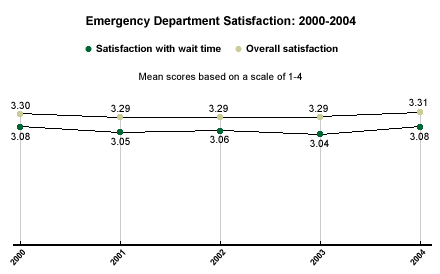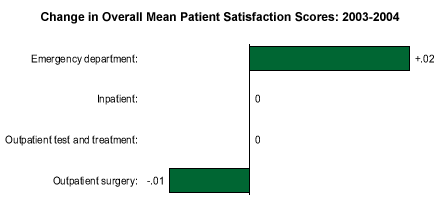For those who work in hospitals, it probably isn't surprising that the emergency department is the lowest-rated service area of the four (inpatient, emergency department, outpatient test and treatment, and outpatient surgery) for which ║┌┴¤═° tracks patient feedback. Emergency departments are regularly declared to be in a state of crisis, and the result has been an intense focus in most hospitals on emergency department operations and the inpatient-emergency department interface.
But now there is some good news for America's emergency departments. ║┌┴¤═°'s newly released healthcare database for the 2004 calendar year (based on nearly 200,000 patient interviews from 385 hospitals) shows one important emergency department satisfaction item -- wait time -- improved more from 2003 than any other item across all four service areas. The improvement in wait time has led to an increase in overall emergency department patient satisfaction.

The Importance of Wait Time Improvement
Satisfaction with wait time is the greatest "dissatisfier" of all the core emergency department satisfaction items; it garners the lowest mean satisfaction score of any core item. Wait time satisfaction dropped from a mean score of 3.08 in 2000 to a score of 3.04 in 2003, but increased back to 3.08 in 2004.
Large data aggregates like the ║┌┴¤═° healthcare database tend to remain stable over time, so the .04-point increase between 2001 and 2004 is more meaningful than it might appear. Even more significantly, the emergency department is the only service area to improve its overall satisfaction score between 2003 and 2004.

Why Have Emergency Departments Improved?
Several years ago I worked with a medical director who was faced with an antiquated emergency department that was too small for its current volume. The medical director told me her department's scores would not improve until the hospital built a new emergency facility. But the hospital hired a new medical director several months later, and scores improved significantly. Although an updated facility had not been built, the new director knew every detail of the emergency department's process and devoted constant attention to improving patient flow. That attention to detail led to improved patient satisfaction, despite cramped quarters and old equipment.
I'm now observing this same phenomenon across the country. Improving satisfaction with emergency departments doesn't necessarily depend on new construction, even if that construction is badly needed. It can also result from increased focus on improving processes and patient-staff interactions.
I have observed several improvements in emergency departments across the country that may be helping drive increased satisfaction:
- implementation of emergency department bedside registration
- expansion of fast-track minor emergency services
- holding area processing of inpatient admissions needing a bed
- staggered scheduling for emergency and ancillary staff members to increase staffing during peak volume periods
- greater emphasis on patient registration triage
Bottom Line
Emergency departments are badly in need of good news, and this increase in scores is worthy of celebration. But there is much more work to be done -- scores remain unacceptably low. Most patients are now reporting acceptable wait times, but a minor system breakdown can still cause massive delays and unhappy customers. Even the best emergency departments must work to reduce inconsistent performance and continue to focus on improving patient-staff interactions.